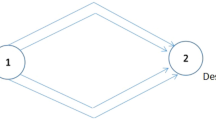Abstract
Macroscopic or flow-based dynamic traffic assignment (DTA) models normally treat traffic in each direction on a roadway as a single lane and, since they do not consider multiple lanes, they can not consider lane-changing behaviour. To investigate how the results may be affected by explicitly considering lanes and lane changing, we consider a road link that consists of two adjacent homogeneous lanes. We assume that traffic entering each lane already knows in which lane it wishes to exit at the end of the link, whether it wishes to exit in the same lane or in the other lane. We model the traffic flows in each lane using a cell transmission model but adapt it to allow for traffic moving from cells in one lane to cells in the other lane. The CTM is used because it handles the modelling of queues and their spillback in an intuitive and widely accepted manner, and our extensions of it allow congestion in one lane to spill back into adjacent lanes. In particular, we investigate how lane-changing and congestion are affected by varying the assumptions concerning two key behavioural parameters, namely the locations at which drivers wish to change lanes and the vehicle spacing needed for lane changing (gap acceptance) as compared to the spacing needed when staying in the same lane (car following). We conclude that there are many situations where modelling a link as a single lane will give a poor approximation to the underlying multi-lane behaviour, or be unable to capture issues of interest, and for those situations multi-lane modelling is appropriate.









Similar content being viewed by others
References
Balijepalli C, Carey M, Watling D (2010) Introducing lanes and lane-changing in a cell-transmission model. Presented at the Third International Symposium on Dynamic Traffic Assignment (DTA2010), held in Takayama, Japan, 29–31 July 2010
Boyce D, Lee D-H, Ran B (2001) Analytical models of the dynamic traffic assignment problem. Network Spatial Econ 1(3–4):377–390
Carey M (2004) Link travel times I: Desirable properties. Network Spatial Econ 4:257–268
Carey M (2006) Introducing lane-changing into the CTM and DTA. Presentation at UCL Traffic Flow Workshop—Sept 2006, Centre for Transport Studies, UCL, 11–12 Sept. 2006. http://www2.cege.ucl.ac.uk/cts/TrafficFlow/pdfs/Carey.pdf
Carey M, Balijepalli C, Watling D (2012). The cell transmission model with multiple lanes and lane-changing. Presented at the Fourth International Symposium on Dynamic Traffic Assignment (DTA2012), held on Martha’s Vineyard, Massachusetts, USA, 4–6 June 2012
Carey M, Watling D (2003) Introduction to a special issue on dynamic traffic assignment. Network Spatial Econ 3(3):403–406, Due to a printing error, it appears in Issue 3(4) of the journal
Carey M, Watling D, Balijepalli C (2011) Ensuring first-in-first-out in cell transmission models. Research report: Institute for Transport Studies, University of Leeds, Leeds LS2 9JD. Submitted for publication
Daganzo CF (1994) The cell transmission model: a dynamic representation of highway traffic consistent with the hydrodynamic theory. Transp Res B 28(4):269–287
Daganzo CF (1995a) The cell transmission model, Part II: network traffic. Transp Res B 29(2):79–93
Daganzo CF (1995b) A finite difference approximation of the kinematic wave model of traffic flow. Transp Res B 29(4):261–276
Gazis DC, Herman R, Weiss GH (1962) Density oscillations between lanes of a multilane highway. Oper Res 10:658–667
Jin W-L (2010a) Macroscopic characteristics of lane-changing traffic. Trans Res Record: J of the Trans Res Board 2188:55–63
Jin W-J (2010b) A kinematic wave theory of lane-changing traffic flow. Transp Res B 44:1001–1021
Laval JA (2003) Some properties of a multi-lane extension of the kinematic wave model. TRB 2003 Annual Meeting CD-ROM. Also, ITS Technical Report UCB-ITS-WP-2003-1, University of California Berkeley
Laval JA, Daganzo CF (2006) Lane-changing in traffic streams. Transp Res B 40(3):251–264
Laval JA, Leclercq L (2008) Microscopic modeling of the relaxation phenomenon using a macroscopic lane-changing model. Transp Res B 42:511–522
Lighthill MJ, Whitham GB (1955) On kinematic waves. I: flow movement in long rivers II: a theory of traffic flow on long crowded roads. Proc R Soc A 229:281–345
Michalopoulos PG, Beskos DE, Yamauchi Y (1984) Multilane traffic flow dynamics: some macroscopic considerations. Transp Res B 18:377–395
Munjal PK, Pipes LA (1971) Propagation of on-ramp density perturbations on unidirectional two- and three-lane freeways. Transp Res B 5:241–255
Peeta S, Ziliaskopoulos AK (2001) Foundations of dynamic traffic assignment: the past, the present and the future. Network Spatial Econ 1(3–4):233–265
Richards PI (1956) Shock waves on the highway. Oper Res 4:42–51
Tang TQ, Wong SC, Huang HJ, Zhang P (2009) Macroscopic modeling of lane-changing for two-lane traffic flow. J Adv Trans 43(3):245–273
Zhong R, Sumalee A, Panl T, Lam WHK (2012) A cell transmission model with lane changing and incorporation of stochastic demand and supply uncertainties for freeway traffic state estimation. Submitted to Networks and Spatial Economics and presented at the Fourth International Symposium on Dynamic Traffic Assignment, held Masachusetts, USA, 4–6 June 2012
Acknowledgment
We wish to thank the two referees for their thoughtful comments, and thank the UK Engineering and Physical Science Research Council (EPSRC) for funding this research via grant EP/G051879. An earlier version of this paper (Carey et al. 2012) was presented at the Fourth International Symposium on Dynamic Traffic Assignment (DTA2012), held at Martha’s Vineyard, Massachusetts, USA, 4–6 June 2012.
Author information
Authors and Affiliations
Corresponding author
Rights and permissions
About this article
Cite this article
Carey, M., Balijepalli, C. & Watling, D. Extending the Cell Transmission Model to Multiple Lanes and Lane-Changing. Netw Spat Econ 15, 507–535 (2015). https://doi.org/10.1007/s11067-013-9193-7
Published:
Issue Date:
DOI: https://doi.org/10.1007/s11067-013-9193-7




